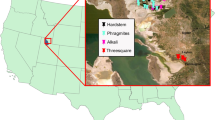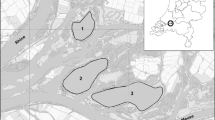Abstract
Macrophytes provide food and shelter for aquatic invertebrates and fish, while also acting as reservoirs for nutrients and trace elements. Zinc accumulation has been reported for various Lemnaceae species. However, comparative accumulation across species and the link between zinc accumulation and toxicity are poorly understood. Morphological distribution and cellular storage, in either bound or soluble form, are important for zinc tolerance. This study shows differences in the uptake and accumulation of zinc by three duckweed species. Landoltia punctata and Lemna minor generally accumulated more zinc than Lemna gibba. L. minor, but not L. gibba or L. punctata, accumulated greater concentrations of zinc in roots compared to fronds when exposed to high levels of zinc. The proportion of zinc stored in the bound form relative to the soluble-form was higher in L. minor. L. punctata accumulated greater concentrations of zinc in fronds compared to roots and increased the proportion of zinc it stored in the soluble form, when exposed to high zinc levels. L. gibba is the only species that significantly accumulated zinc at low concentrations, and was zinc-sensitive. Overall, internal zinc concentrations showed no consistent correlation with toxic effect. We conclude that relationships between zinc toxicity and uptake and accumulation are species specific reflecting, among others, zinc distribution and storage. Differences in zinc distribution and storage are also likely to have implications for zinc bioavailability and trophic mobility.





Similar content being viewed by others
References
Amado Filho G, Karez C, Pfeiffer W, Yoneshigue-Valentin Y, Farina M (1996) Accumulation, effects on growth, and localization of zinc in Padina gymnospora (Dictyotales, Phaeophyceae). Hydrobiologia 326(1):451–456
Baldantoni D, Alfani A, Di Tommasi P, Bartoli G, De Santo A (2004) Assessment of macro and microelement accumulation capability of two aquatic plants. Environ Poll 130(2):149–156
Barwick M, Maher W (2003) Biotransference and biomagnification of selenium copper, cadmium, zinc, arsenic and lead in a temperate seagrass ecosystem from Lake Macquarie Estuary, NSW, Australia. Mar Environ Res 56(4):471–502
Bassi R, Sharma SS (1993) Changes in proline content accompanying uptake of zinc and copper by Lemna minor. Ann Bot 72(2):151–154
Brain RA, Solomon KR (2007) A protocol for conducting 7-day daily renewal tests with Lemna gibba. Nat Protoc 2(4):979–987
Brain R, Johnson D, Richards S, Sanderson H, Sibley P, Solomon K (2004) Effects of 25 pharmaceutical compounds to Lemna gibba using a seven day static renewal test. Environ Toxicol Chem 23(2):371–382
Cardwell AJ, Hawker DW, Greenway M (2002) Metal accumulation in aquatic macrophytes from southeast Queensland, Australia. Chemosphere 48(7):653–663
Chen CY, Stemberger RS, Klaue B, Blum JD, Pickhardt PC, Folt CL (2000) Accumulation of heavy metals in food web components across a gradient of lakes. Limnol Oceanogr 45(7):1525–1536
Clemens S (2001) Molecular mechanisms of plant metal tolerance and homeostasis. Planta 212(4):475–486
Davies KL, Davies MS, Francis D (1992) Zinc-induced vacuolation in root meristematic cells of cereals. Ann Bot 69(1):21–24
Dirilgen N, Inel Y (1994) Effects of zinc and copper on growth and metal accumulation in duckweed, Lemna minor. Bull Environ Contam Toxicol 53(3):442–449
Drost W, Matzke M, Backhaus T (2007) Heavy metal toxicity to Lemna minor: studies on the time dependence of growth inhibition and the recovery after exposure. Chemosphere 67(1):36–43
Eide DJ (2006) Zinc transporters and the cellular trafficking of zinc. BBA Mol Cell Res 1763(7):711–722
Eisler R (1993) Zinc hazards to fish, wildlife, and invertebrates: a synoptic review. US Department of the Interior. Fish and Wildlife Service, Washington
Ellis JB, Shutes RB, Revitt DM, Zhang TT (1994) Use of macrophytes for pollution treatment in urban wetlands. Resour Conserv Recycl 11(1–4):1–12
Fayed SE, Abd-El-Shafy HI (1985) Accumulation of Cu, Zn, Cd, and Pb by aquatic macrophytes. Environ Int 11(1):77–87
Frey B, Keller C, Zierold K, Schulin R (2000) Distribution of Zn in functionally different leaf epidermal cells of the hyperaccumulator Thlaspi caerulescens. Plant Cell Environ 23(7):675–687
Fritioff A, Greger M (2006) Uptake and distribution of Zn, Cu, Cd, and Pb in an aquatic plant Potamogeton natans. Chemosphere 63(2):220–227
Gaither LA, Eide DJ (2001) Eukaryotic zinc transporters and their regulation. BioMetals 14(3):251–270
Gaur JP, Noraho N, Chauhan YS (1994) Relationship between heavy metal accumulation and toxicity in Spirodela polyrhiza (L.) Schleid. and Azolla pinnata R. Br Aquat Bot 49(2–3):183–192
Hare L (1992) Aquatic insects and trace metals: bioavailability, bioaccumulation, and toxicity. Crit Rev Toxicol 22(5–6):327–369
Hargreaves JW, Whitton BA (1976) Effect of pH on tolerance of Hormidium rivulare to zinc and copper. Oecologia 26(3):235–243
Harper C, Bolen E (1996) Duckweed (Lemnaceae) as habitat for macroinvertebrates in eastern North Carolina. Wetlands 16(2):240–244
Huebert D, Shay J (1992) The effect of EDTA on cadmium and zinc uptake and toxicity in Lemna trisulca L. Arch Environ Contam Toxicol 22(3):313–318
Ikemoto T, Tu N, Okuda N, Iwata A, Omori K, Tanabe S, Tuyen B, Takeuchi I (2008) Biomagnification of trace elements in the aquatic food web in the Mekong Delta, South Vietnam using stable carbon and nitrogen isotope analysis. Arch Environ Contam Toxicol 54(3):504–515
Jansen M, van den Noort R, Boeke S, Huggers S, de Haan J (1999) Differences in UV-B tolerance among Spirodela punctata ecotypes. J Photochem Photobiol B Biol 48(2–3):194–199
Jiang X, Wang C (2008) Zinc distribution and zinc-binding forms in Phragmites australis under zinc pollution. J Plant Physiol 165(7):697–704
Kara Y (2004) Bioaccumulation of copper from contaminated wastewater by using Lemna minor. Bull Environ Contam Toxicol 72(3):467–471
Khellaf N, Zerdaoui M (2009) Phytoaccumulation of zinc by the aquatic plant, Lemna gibba L. Bioresour Technol 100(23):6137–6140
Kobae Y, Uemura T, Sato MH, Ohnishi M, Mimura T, Nakagawa T, Maeshima M (2004) Zinc transporter of Arabidopsis thaliana AtMTP1 is localized to vacuolar membranes and implicated in zinc homeostasis. Plant Cell Physiol 45(12):1749–1758
Kramer U, Pickering IJ, Prince RC, Raskin I, Salt DE (2000) Subcellular localization and speciation of nickel in hyperaccumulator and non-accumulator Thlaspi species. Plant Physiol 122(4):1343–1354
Küpper H, Lombi E, Zhao F, McGrath S (2000) Cellular compartmentation of cadmium and zinc in relation to other elements in the hyperaccumulator Arabidopsis halleri. Planta 212(1):75–84
Lahive E, O’Halloran J, Jansen MAK (2011) Differential sensitivity of four Lemnaceae species to zinc sulphate. Environ Exp Bot 71(1):25–33
Li T-Q, Yang X-E, Yang J-Y, He Z-L (2006) Zn accumulation and subcellular distribution in the Zn hyperaccumulator Sedum alfredii Hance. Pedosphere 16(5):616–623
Maage A, Julshamn K, Berge GE (2001) Zinc gluconate and zinc sulphate as dietary zinc sources for Atlantic salmon. Aquac Nutr 7(3):183–187
MacDiarmid CW, Gaither LA, Eide D (2000) Zinc transporters that regulate vacuolar zinc storage in Saccharomyces cerevisiae. EMBO J 19(12):2845–2855
Macnair MR, Bert V, Huitson SB, Saumitou-Laprade P, Petit D (1999) Zinc tolerance and hyperaccumulation are genetically independent characters. Proc R Soc Lond Biol 266(1434):2175
McGeer J, Brix K, Skeaff J, DeForest D, Brigham S, Adams W, Green A (2003) Inverse relationship between bioconcentration factor and exposure concentration for metals: implications for hazard assessment of metals in the aquatic environment. Environ Toxicol Chem 22(5):1017–1037
Megateli S, Semsari S, Couderchet M (2009) Toxicity and removal of heavy metals (cadmium, copper, and zinc) by Lemna gibba. Ecotoxicol Environ Saf 72(6):1774–1780
Miretzky P, Saralegui A, Cirelli A (2004) Aquatic macrophytes potential for the simultaneous removal of heavy metals (Buenos Aires, Argentina). Chemosphere 57(8):997–1005
Mishra VK, Tripathi BD (2009) Accumulation of chromium and zinc from aqueous solutions using water hyacinth (Eichhornia crassipes). J Hazard Mater 164(2–3):1059–1063
Newman RM (1991) Herbivory and detritivory on freshwater macrophytes by invertebrates: a review. J N Am Benthol Soc 10(2):89–114
Nishizono H, Ichikawa H, Suziki S, Ishii F (1987) The role of the root cell wall in the heavy metal tolerance of Athyrium yokoscense. Plant Soil 101(1):15–20
OECD (2002) OECD Guidelines for the testing of chemicals: Revised proposal for a new guideline 221. Lemna sp. growth inhibition test. OECD, Paris
Palmiter RD (2004) Protection against zinc toxicity by metallothionein and zinc transporter 1. Proc Natl Acad Sci USA 101(14):4918–4923. doi:10.1073/pnas.0401022101
Pandit A (1984) Role of macrophytes in aquatic ecosystems and management of freshwater resources. J Environ Manag 18(7):73–88
Peng K, Luo C, Lou L, Li X, Shen Z (2008) Bioaccumulation of heavy metals by the aquatic plants Potamogeton pectinatus L. and Potamogeton malaianus Miq. and their potential use for contamination indicators and in wastewater treatment. Sci Total Environ 392(1):22–29
Qiu R, Thangavel P, Hu P, Senthilkumar P, Ying R, Tange Y (2011) Interaction of cadmium and zinc on accumulation and sub-cellular distribution in leaves of hyperaccumulator Potentilla griffithii. J Hazard Mater 186(2–3):1425–1430
Ramsay LM, Gadd GM (1997) Mutants of Saccharomyces cerevisiae defective in vacuolar function confirm a role for the vacuole in toxic metal ion detoxification. FEMS Microbiol Lett 152(2):293–298
Rau S, Miersch J, Neumann D, Weber E, Krauss GJ (2007) Biochemical responses of the aquatic moss Fontinalis antipyretica to Cd, Cu, Pb and Zn determined by chlorophyll fluorescence and protein levels. Environ Exp Bot 59(3):299–306
Rout G, Das P (2003) Effect of metal toxicity on plant growth and metabolism: I. Zinc. Agronomie 23(1):3–11
Sela M, Garty J, Tel-Or E (1989) The accumulation and the effect of heavy metals on the water fern Azolla filiculoides. New Phytol 112(1):7–12
Shilla D, Asaeda T, Fujino T, Sanderson B (2006) Decomposition of dominant submerged macrophytes: implications for nutrient release in Myall Lake, NSW, Australia. Wetl Ecol Manag 14(5):427–433
Sresty T, Madhava Rao K (1999) Ultrastructural alterations in response to zinc and nickel stress in the root cells of pigeonpea. Environ Exp Bot 41(1):3–13
USEPA (1996) Aquatic plant toxicity test using Lemna spp., Tiers I and II “Public Draft”. EPA 712-C-96–156. United States Environmental Protection Agency, Washington
Vesk P, Nockolds C, Allaway W (1999) Metal localization in water hyacinth roots from an urban wetland. Plant Cell Environ 22(2):149–158
Vijver MG, van Gestel CAM, Lanno RP, van Straalen NM, Peijnenburg WJGM (2004) Internal metal sequestration and its ecotoxicological relevance: a review. Environ Sci Technol 38(18):4705–4712. doi:10.1021/es040354g
Wallace W, Lopez G, Levinton J (1998) Cadmium resistance in an oligochaete and its effect on cadmium trophic transfer to an omnivorous shrimp. Mar Ecol Prog Ser 172:225–237
Wang J, Evangelou B, Nielsen M, Wagner G (1992) Computer simulated evaluation of possible mechanisms for sequestering metal ion activity in plant vacuoles: II. Zinc. Plant Physiol 99(2):621
Weiner JA, DeLorenzo ME, Fulton MH (2004) Relationship between uptake capacity and differential toxicity of the herbicide atrazine in selected microalgal species. Aquat Toxicol 68(2):121–128
WHO (1996) Guidelines for drinking water quality, vol 2. Health criteria and other supporting information, 2nd edn. World Health Organisation, Geneva
Zhang L, Wang W-X (2006) Significance of subcellular metal distribution in prey in influencing the trophic transfer of metals in a marine fish. Limnol Oceanogr 51(5):2008–2017
Acknowledgments
This work was funded by IRCSET (Irish Research Council for Science, Engineering and Technology). The authors gratefully acknowledge Mr. David White for his expert work in maintaining the Lemnaceae collection at University College Cork. We also appreciate the assistance and guidance of Ms. Noreen Casey and Dr. Patrick Kiely of the Department of Biochemistry, University College Cork, in the maintaining and use of the liquid scintillation counter.
Author information
Authors and Affiliations
Corresponding author
Rights and permissions
About this article
Cite this article
Lahive, E., O’Callaghan, M.J.A., Jansen, M.A.K. et al. Uptake and partitioning of zinc in Lemnaceae . Ecotoxicology 20, 1992–2002 (2011). https://doi.org/10.1007/s10646-011-0741-y
Accepted:
Published:
Issue Date:
DOI: https://doi.org/10.1007/s10646-011-0741-y




